Dynamic expressions in tool descriptions
This page contains expressions written using the sbg:draft-2 version of the Common Workflow Language. For CWL v1.0 expressions, please see this page.
The tool editor allows you to describe the features and behavior of your command line tool. The resulting description is used to create an interface between your tool and other tools that can be run on the Platform.
Overview
If your tool has a certain behavior, controlled by a command line option argument, that you don't want to ever vary with executions, you can 'hard code' this into the tool description. On the other hand, if you want to chose the argument every time you run the tool, you can manually input it with each execution. But, in many cases, a middle way is more appropriate: although the required argument will vary with executions, it should do so in a deterministic way, dependent on other features of the tool execution.
To achieve this behavior, you can hard code the argument using a dynamic expression in your tool description, rather than a literal. It can be expressed in terms of the inputs, outputs, or other aspects of a tool execution; the object that the expression refers to will then be determined at runtime on the basis of the values of these other objects.
Using dynamic expressions
Dynamic expressions are given in Javascript. You can enter a dynamic expression anywhere in the tool editor where you find the symbol </>. For example, you could enter the Javascript expression 1+2, or a function body such as {return 1+2}.
Places where you might want to use dynamic expressions include:
- Giving your tool's base command.
- Specifying the command options for your tool. Options related to tool inputs are set on the Inputs tab, and others are set in the Arguments field on the General Information tab.
- Specifying stdin and stdout.
- Setting the resources allocated to your tool (memory and CPU number).
- Setting up the glob pattern to catch outputs, on the Outputs tab.
Predefined Javascript objects:
Some Javascript objects have been defined in the scope of the tool execution, and are available for you to use in dynamic expressions to increase their expressivity. The objects, $job and $self, denote properties of the ongoing tool execution (the job), and the tool's inputs or outputs in a given execution. They are described below.
The $job object
$job objectThe object $job refers to an ongoing tool execution. It has the properties inputs and allocatedResources, which, in turn, have further properties that describe the execution in question.
-
inputs
This is an object that denotes the inputs for the tool. Recall that tool inputs include files and parameters.The inputs object has the properties<input_id>and<input_value>.-
<input_id>is the ID that you have labeled each input port with on the tool editor. -
<input_value>refers to the object that is entered into the port named<input_id>. It is set according to the following rule, illustrated in the table below: If the object entered into the port named<input_id>is any data type other than a file, then<input_value>is the object itself. If the object entered into the port<input_id>is a file, then<input_value>is four objects that describe, and uniquely determine, the file.
-
Data type input to the port named input_id |
|
|---|---|
File | The following four objects are the input_value:
: this is a list of secondary files (index files) attached to the file. It may be empty. `path`: this is the file path.
: this is the file size. |
String | The string entered to the input port. |
Enum | The enumerator of the enumerated type that is entered to the input port labeled by
|
Int | The integer entered to this input port. |
Float | The float entered to this input port. |
Boolean | The boolean value entered to this input port. |
Array | The array entered to this input port. |
-
allocatedResources
This is the second property of the objectinputs. it is an object with properties:cpuandmem: -
cpurepresents the number of CPU cores that have been allocated to the tool for the execution in question. -
memrepresents the memory in megabytes that has been allocated to the tool for the execution in question.
Required resources andallocatedResourcesNote that the required resources, entered under 'Resources' on the General Information tab differ from the
allocatedResourcesobject in$job: for optimization, more resources may be allocated to the tool than it actually requires to function. The resources actually allocated depend on the particular execution environment, whereas the required resources are a hard requirement of the tool.
Inspecting the $job object
$job objectThe objects in <input_value> are defined at runtime, depending on which strings, ints, files, and so on are inputted to the tool. But we can use the Test tab to set dummy inputs, and then inspect the $job object.
To see the $job object for your tool description and test values:
- Click the cog icon for Settings in the top right hand corner of the Tool Editor.
- Select the option </> Job JSON.
You will see a pop-up window displaying $job, expressed in Javascript Object Notation (JSON), for the test values entered.
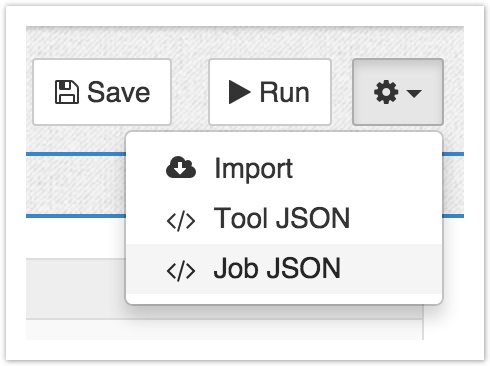
</> Job JSON
In order to get a better understanding of what input_id and input_value denote, let's create a tool description in the editor that has input ports for different selected data types, and then view the $job.
Examples of the $job object
$job objectExample 1
We'll try adding input ports that take a range of different data types as input.
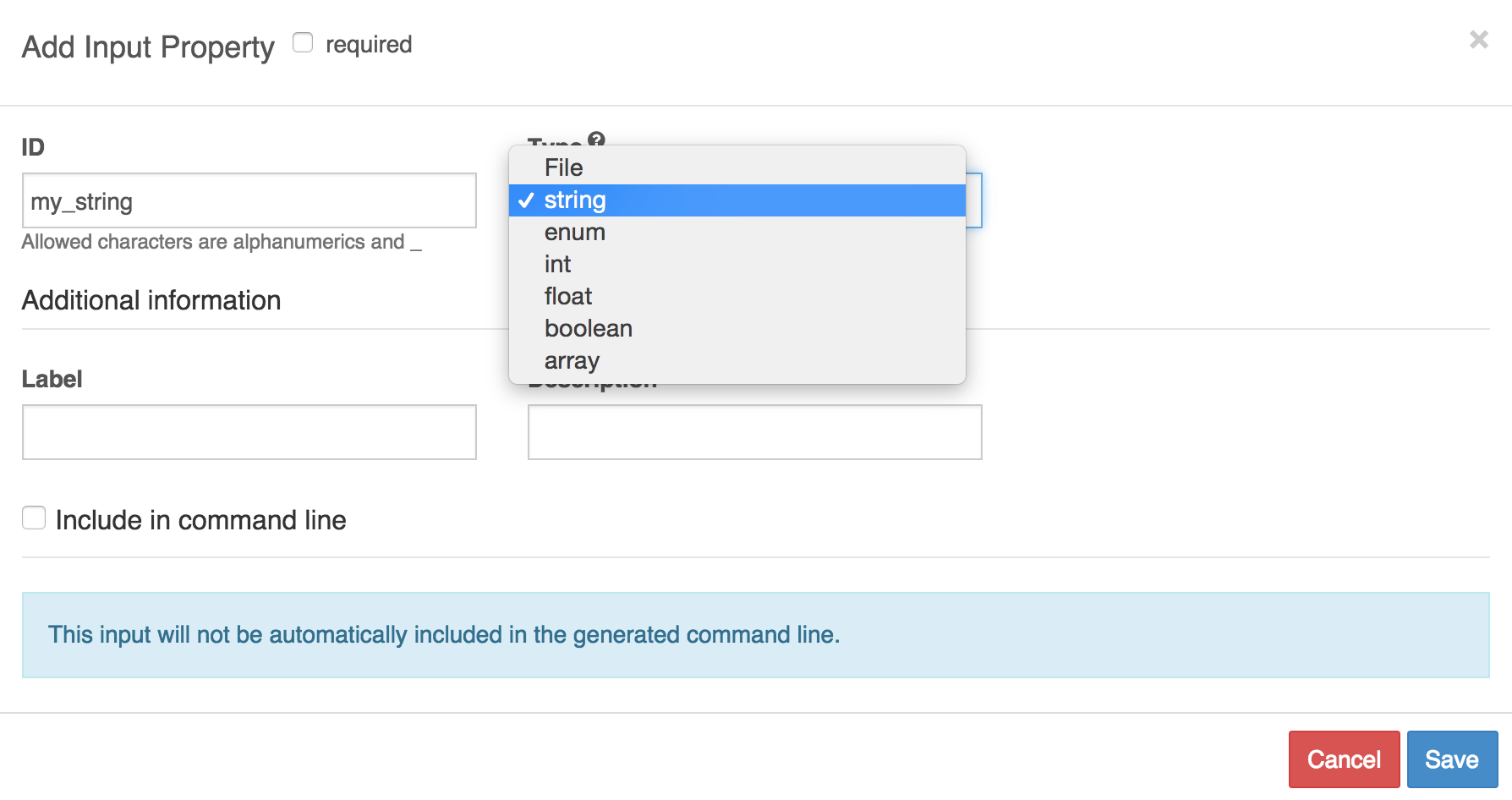
Example 1: entering input ports on the tool editor
For example, create the following ports on the Inputs tab:
- Port ID:
my_file, Input type: file - Port ID:
my_string, Input type: string - Port ID:
my_enum, Input type: enum; enumerations: red, yellow, green blue - Port ID:
my_int, Input type: int - Port ID:
my_boolean, Input type: boolean
On the Test Tab you can set the values of these ports.
- Set
my_stringto 'here is a test string'; - Set
my_intto 6; - Set
my_booleanto True (indicated by checking the box); - Set
my_fileto test_file.etx; - Set
my_enumto yellow (selected from the enumerations we defined when creating the port).
These settings are shown in the screenshot of the Test tab, below:
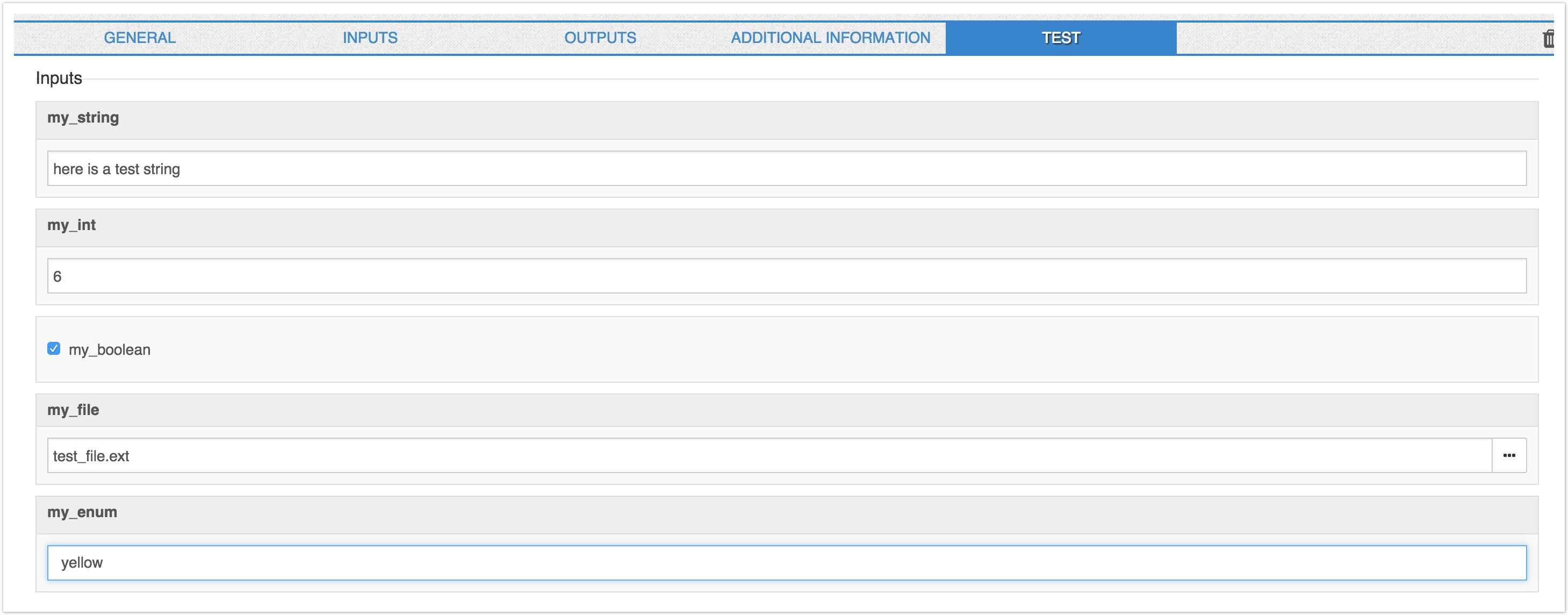
Example 1: entering values to be used as inputs
Now that we have set the values for the objects inputted to the tool ports, let's look at the $job object. Click </> Job JSON under the settings cog icon in the top right corner.
The resulting $job object in JSON looks like this:

$job JSON for a tool with ports for multiple data types
You can see that each input port is associated with the value of the object that is inputted to it, as set on the Test tab. The input port for files, my_file, is associated with the four objects that describe the file inputted to that port: path, class, size, and secondaryFiles. These associated objects are the <input_value> for the input ports.
The allocatedResources object in the $job also contains the same values as set (by default) on the Test tab.
If we were to execute this tool, the values of <input_value> would change to the actual strings, ints, files, and so on inputted to the tool.
Example 2
Here is a more concrete example. Suppose that you have a tool whose input port IDs are reads and trim_size. In this case, reads takes files as input type, and trim_size takes integers. If we enter '10' for trim_size, and 'reads_file.ext' for reads in the Test Tab then the job object would look like this:
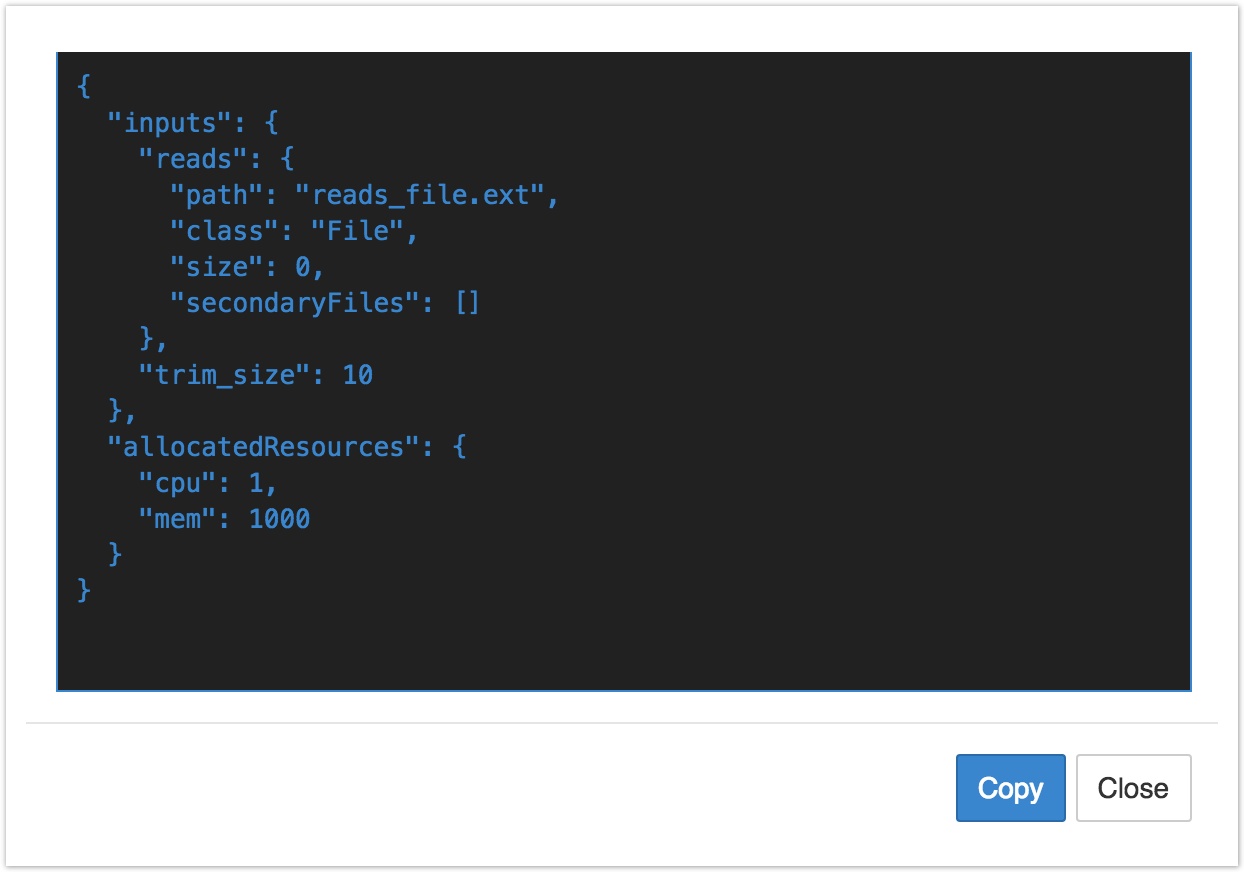
$job JSON for a tool with ports reads and trim_size
Examples of $job usage
$job usageEarlier, we listed fields in which you may want to use the $job object in dynamic expressions. Here are a few examples:
-
You may need to set the tool's required memory (on the General Information tab) to be a function of the size of the inputted file. In this case, you can use the object
$job.inputs.<input_id>.sizeto pick out the size of the file inputted to the port<input_id>. -
You may need to pass the number of CPUs allocated to the tool in as an argument, for instance, to be the value of the argument for thread number,
num-threads. In this case, in the Arguments field in the General Information tab, enter following object to pick out the CPUs allocated to the job at runtime. This example is illustrated below:

Example 2: Enter the number of threads as a argument, using $job.
- You can use
$jobto perform string manipulation on file paths to extract file names. If, for example, you are copying files to the current working directory of the job, you will need to specify: (a) the file name and (b) the file to be copied. (These are specified in the field marked Create Files on the General Information tab; see the section on Attaching Index Files for information on this use case.) - (a) The file name for the file input to the tool is obtained from the path property of the <input_id> object for the input port that takes files. The path of the input file is is $job.inputs.<input_id>.path.
To get the file name, we want to perform string manipulation on the file path; slice the path up by forward slashes, and then select just the final slice of the path. This string manipulation can be performed using the expression: $job.inputs.<input_id>.path.split('/').slice(-1)[0].
(b) The file itself is obtained from <input_id>, for the input port that takes files. Use: $job.inputs.<input_id>.

Below is a screenshot showing how these expressions would be entered in the Create Files fields:

Example 2: Using string manipulation on $job to enter files
Finally, the $job object is used to indicate errors in an imported tool. If a tool referred to in a tool description contains errors, such as a cyclical loop, these will be shown in the online editor and added to the JSON object displayed in the $jobJSON , with the property sbg:errors.
The $self object
$self objectThe $self object is used to modify the value of the input or output that gets passed to the command line.
- In the command line bindings for the tool inputs,
$selfis set to the value of the input. In other words, in this context$selfis just$job.inputs.<input_id>. - In the command line bindings for the tool outputs,
$selfis an object with the propertiespathandsizethat match the globbed file (see here for more information on globbing).
Examples of $self usage
$self usageHere are a few examples of how you can use the $self object:
$self in the Inputs tab
-
Use
$selffor string manipulation. Suppose that your tool takes input files that are entered on the command line, but expects these to be given as filenames, not as file paths. Since$selfrefers to the tool input, in the case that files are the input type$selfwill refer to a full file path. By performing string manipulation on this file path, as in the example above, you can extract the filename. Then, enter this as the input value to the tool. -
Another use case for
$selfis to manipulate an integer input. Suppose that your tool expects integer inputs in exponent notation, but inputs are given as integers. In this case,$selfwill refer to the integer inputted, and you can use an expression in terms of$selfin the Inputs value field to give the integer in its exponent representation.
$self in the Outputs tab
- In addition to using
$selfto refer to a tool's inputs, you can use$self.pathon the Outputs tab in the metadata field to specify to the path of the file matching the glob pattern. You might want to annotate output files with the metadata field 'file type', whose value depends on the particular extension of the file being output by the tool. In this case, set the metadata key to file_type and set the value to the Javascript expression $self.path.split('.').slice(-1)[0] to refer to the part of the file path after the dot, i.e. the extension. This is shown on the screenshot below.
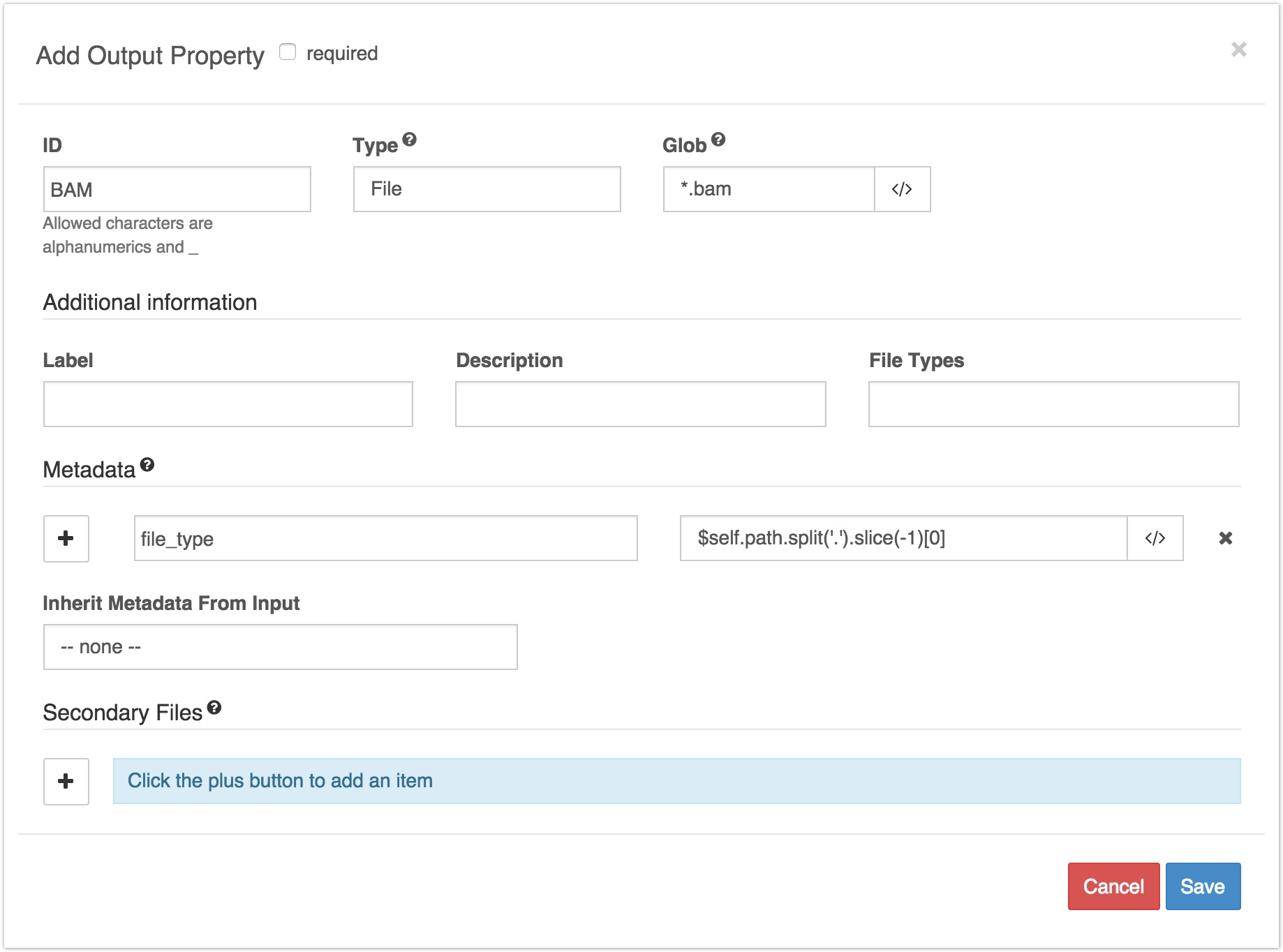
Using $self to add file-type metadata to output files
Updated about 2 months ago
